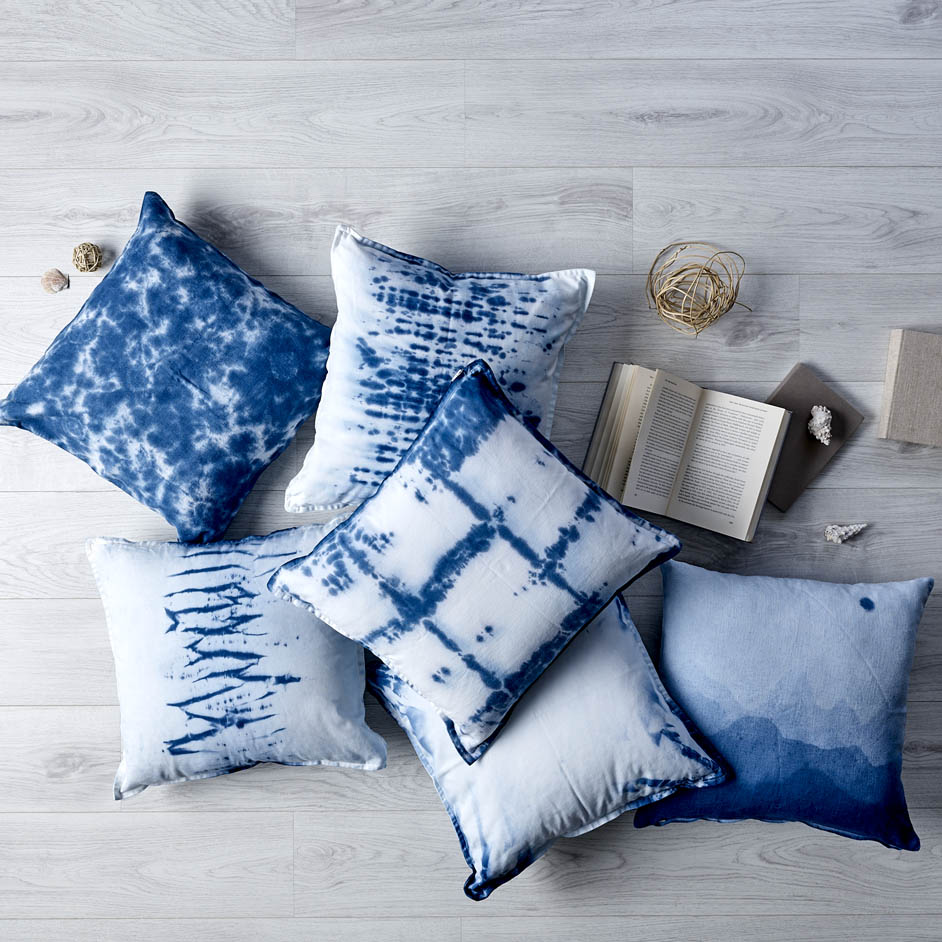 | ||
| Your browser is not supported. | ||
|
Please browse our site using any of the following options:
| ||
COASTAL SHIBORI CUSHION COVERS

LEVEL: EASY
WHAT YOU'LL NEED:
- 'Tulip' Tie Dye Kit.
- Cushion Cover/s
- Elastic bands that come with the kit,
- Marbles,
- Bulldog clips,
- Thread
- Chop sticks.
INSTRUCTIONS
- Before commencing pre-wash your pre-purchased cushion covers or fabric. To remove any sizing and dry them. Dryer is fine to use. Give them an iron or else leaving them slightly wrinkly can aid in a more abstract interesting effect. The technique used this time was on dry washed fabric but the instructions below can be used on wet fabrics for further interesting results.
Mix the dye
Follow the instructions on the Tulip Spray Dye Kit or Tulip Tie Dye Kit.
We used the 'Blue" in the Tulip Spray Dye Kit, Make sure the dye is fully mixed before using. Set aside for the moment, but make sure the dye is used within 24 hrs otherwise it begins to lose its concentration and the colour becomes weaker.
Prepare the fabric
Landscape stencil Cushion
Workout your design on paper. This was a simple design based on torn news print.
Newsprint was torn in a rough shape of the mountains.
Tearing the paper gives it a soft blend-able edges result. We will be working in layers using the stencil.
- you can use (scissors/blade) if you do not want to tear the paper, this will give you a harder line as a result. Prepare the stencil to mask out any areas you do not want
the dye to go to. The masking can be in the form of newsprint, masking tape etc. anything that will cover the area that you do not want the dye to go onto. This can be done with one stencil but in the case of the landscape cushion I had two stencils ready.
Prepare your work area
Lay out some plastic sheets over your table area. Lay your cushion fabric on the table.
Mask any areas you do not want the dye.
Spray, set and then rinse
Shake the bottle, unlock the nozzle and spray the first amount onto some paper towels to make sure that the dye squirts out evenly. I initially very lightly sprayed the whole area and then laid my mask down. The masking stencil will do two things - it will cover any area you wish to remain in the light first spray and it will leave area's exposed to accept further spraying of the dye. Once the mask is in place spray the area with the dye. This will give your fabric another layer of dye and your hue will be another shade darker than your initial spray - roughly what we would call our second light tone.
Don't flood it too much as we will be moving the mask twice more to create our mid-tone and our darkest tone. Keep in mind to wait a minute or so between the layer so
that that the dye has a chance to seep into the fabric. Once you have done this you can remove the last stencil and have a look at your creation. If you feel that areas could be darker replace the stencil and give it another spray of the dye. Keep spraying until your desired tone has been achieved. Once the initial wetness of the spray dye had seeped into the fabric a piece of gladwrap was placed over the fabric and left to dry for approx. 8 hours.
Rinse
Rinse well with water until all the excess dye has been removed. Place in washing machine and give it a good wash. Wash separately. Dry the fabric.
INSTRUCTIONS
- Before commencing pre-wash your pre-purchased cushion covers or fabric.
To remove any sizing and dry them. Dryer is fine to use. Give them an iron or else leaving them slightly wrinkly can aid in a more abstract interesting effect. The technique used this time was on dry washed fabric but the instructions below can be used on wet fabrics for further interesting results.
Mix the dye
Follow the instructions on the Tulip Spray Dye Kit or Tulip Tie Dye Kit. We used the 'Blue" in the Tulip Tie Dye Kit, Make sure the dye is fully mixed before using. Set aside for the moment, but make sure the dye is used within 24 hrs otherwise it begins to lose its concentration and the colour becomes weaker.
Prepare the fabric
Shibori Style techniques
We used elastic bands that come with the kit, marbles, bulldog clips, thread and chop sticks.
The types of folds we did.
i. Fold cushion covers into a tri-fold until it looks like a nice 'squarish package. Insert chopsticks between the folds. Wrap ends in elastic bands.
ii. Fold corners with elastic bands
iii. Open cushion case, insert marble at various sections of the cloth and tie up with elastic bands on the outside of the fabric.
iv. Fold sections of the fabric into linear lines and clip a bulldog clip at various intervals.
We started from the centre and did approx. 10 linear rows.
v. With some thick thread we just did several basic running stitch across the fabric in several rows and then pulled the threads until the fabric scrunched up into half its size.
Any areas that we didn't want dye to go into we covered in gladwrap and secured it with elastic bands.
Prepare your work area
Lay out some plastic sheets over your table area. Lay your cushion fabric on the table.
Mask any areas you do not want the dye.
Spray, set and then rinse
Shake the bottle, apply the dye to all fabric edges, or exposed surfaces that you wish the dye. Wrap the dyed surface with gladwrap to keep it moist. Leave for approx. 8hrs.
Rinse
Remove all elastic bands and items used and rinse well with water until all the excess dye has been removed. Place in washing machine and give it a good wash. Wash
separately. Dry the fabric.




